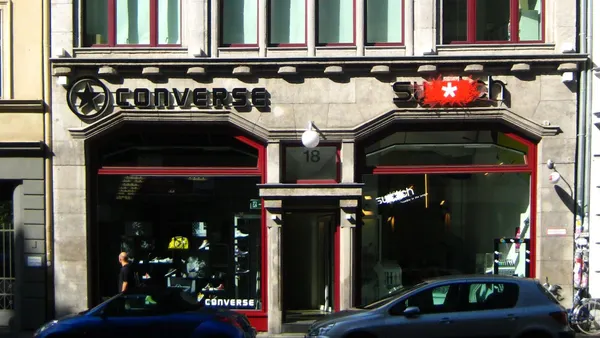Dive Brief:
-
Under Armour on Thursday announced the final component of its restructuring effort — a 3% reduction of its global workforce. That works out to "roughly 400 employees, and is based on a total of approximately 13,500 employees globally," an Under Armour spokesperson told Retail Dive in an email.
-
The cuts are expected to be completed by March 31, 2019, according to a company press release. In light of them, the company adjusted its full-year outlook saying that it now expects its operating loss to be about $60 million, versus its previous expectation for between $50 million and $60 million. (Excluding the plan’s impact, the company now expects adjusted operating income to land between $140 million and $160 million, up from its prior expectation of $130 million to $160 million.)
-
Under Armour is making fundamental changes to its operations, including an inventory pare-down, but is doing so as costs rise. Operating loss in the second quarter was $105 million, and adjusted operating loss was $20 million. Net loss was $96 million or $34 million adjusting for the impact of the company's restructuring plan.
Dive Insight:
Burgeoning expenses have been an issue for Under Armour, and shares rose Thursday on the news of the brand's plans to scale back its workforce, one of the costliest line items for any business.
Under Armour Chief Financial Officer David Bergman called the plan a "difficult decision," but expressed confidence in the company's overall restructuring. "This redesign will help simplify the organization for smarter, faster execution, capture additional cost efficiencies, and shift resources to drive greater operating leverage as we move into 2019 and beyond,” he said in a statement.
The company wouldn't state exactly how many employees would be cut from headquarters, saying it isn't "providing that specific level of detail."
"Baltimore has been the bedrock of our winning brand and we are deeply committed to the city we call home," the spokesperson said. "This community is a key to the innovation that will allow us to reimagine the future. Through this transition, we will be approaching every teammate with the utmost care and respect, but these are necessary steps to become a more operationally excellent company."
But the company's assessment of the decision's financial impact raised questions. "Both outlooks for adjusted operating income and adjusted EPS were raised on their low ends only, despite the $10 million in incremental savings related to the layoffs," Wedbush analysts Christopher Svezia and Paul Nawalany wrote Thursday in comments emailed to Retail Dive. They also questioned why the upper end of its forecasts remained the same. "Overall, our assessment of Under Armour remains unchanged despite the workforce reductions. Clearly the company is looking to rightsize its operating structure ... However, there are still issues around product demand in North America."
The company is struggling to contain costs in many areas and is saddled with long-term debt. "Total liabilities are up by 24% over the prior year, including an increase in current liabilities," GlobalData Retail Managing Director Neil Saunders said in an email to Retail Dive regarding UA's second quarter. "Looking ahead the burden from sponsorship arrangements, which is far higher for Under Armour than for most sporting brands, and an increase in store rent costs will put further pressure on both profits and the balance sheet."
The brand's challenges aren't all financial. "Our data show that Under Armour continues to suffer from an erosion of customers, many of which are migrating to other brands," Saunders warned earlier this year. "More and more consumers are confused about Under Armour's proposition. Given the rather fragmented range, a lack of focus on any particular sport, and a scattergun approach to product development, this is hardly surprising."
UA's struggles come as rivals Adidas and Nike are on the rise, with both showing signs of recovery in the important North America market. Nike, in particular, grabbed headlines with the release of its new "Just Do It" campaign with Colin Kaepernick in a move that remains controversial, garnering both kudos and condemnation. Nike's share price has more than recovered from an initial dip that seemed tied to the Kaepernick association, though it remains to be seen how it all translates to sales.











